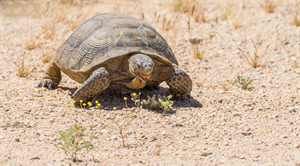
PUMPA - SMART LEARNING
எங்கள் ஆசிரியர்களுடன் 1-ஆன்-1 ஆலோசனை நேரத்தைப் பெறுங்கள். டாப்பர் ஆவதற்கு நாங்கள் பயிற்சி அளிப்போம்
Book Free DemoDetermination
To find whether a particular species is endangered or not, it is determined by the following ways.
- When geographical range of the species is limited.
- The population of species is limited i.e., less than 50 adult individuals.
- When population has decreased or decreases more than 80 \% in 10 \ years.
- If the population is less than 250 individuals and is declining continuously at 25 \% for past three years.
- When there is a high possibility of extinction in the wild.
Causes of endangerment
1. Disturbances or loss of the natural habitat - trees provide food and shelter to many species are destroyed due to human intervention.

Habitat loss
2. Overhunting and poaching - a large number of animals are hunted for their horns, skin, teeth and other valuable products.

Poaching of rhinoceros
3. Pollution - Various animals are affected by pollution like air and water pollution. In recent years, animals are affected by wastes like plastics.
4. New habitat - Animals can be taken to new habitat by the people where they cannot live naturally. Some animals may get extinct, and some survive. The introduction of new animals into the new habitat may cause attack by species that are already living there and causes extinction.
5. Chemicals - Chemicals like pesticides and other chemicals are used to get rid of damaging insects, pests or weeds. They can also harm or poison desired animals and plants.
6. Diseases - Diseases can affect the animals due to various unknown reasons that affect the animals and make it extinct.
7. Introduction of new species or invasive species
8. Natural calamities like flood, fire etc.
How to save endangered species?
Deforestation poses a serious threat to the survival of the wild animals and wild plants and the natural habitat. Nature is filled with a variety of plants and animals. For maintaining a healthy ecological balance, the species of animals and plants are important. They have scientific, medicinal, commercial and ecological value.
Each of the organism that is present in the earth has a unique place in the food chain, which contributes to the ecosystem. Thus, conservation of forests and wildlife is of importance to preserve biodiversity, to prevent the endangered species in becoming extinct, and also to maintain ecological balance. But, since they are endangered due to the human activity, we need to take measures to protect and preserve them that includes:
1. Some animal species are endangered due to hunting and poaching. If poaching is controlled, there can be a significant change in the number of endangered animals. Ban to be imposed on poaching (capture of wild animals and birds).
2. When pollution is controlled, there is a positive impact on animals, fish and birds in the world.
3. When people consume more, more pollutants are put in the environment. By consuming less, we can protect the ecosystem.
4. Animals usually mistake plastic for food and consume them. This causes harm to the animals and cause endangerment of many species. Limiting the amount of plastic and also recycling of plastic saves the endangered animals.
5. Recycling, buying eco-friendly productspreserves the environment and thus the animals.
6. Pesticides that damages and the environment should be avoided.
7. Planting native trees provide food to the animals.
Initiatives taken by the Government:
To preserve plants and animals, the Government has taken and is taking a lot of initiatives and acts passed to protect the ecosystem. Project Tiger is a wildlife conservation project initiated in 1972 by Government of India to protect the Bengal Tiger. The project was launched on 1st April 1973 and aimed to ensure the survival and maintenance of the tiger population. It has become one of the most successful wildlife conservation projects.
Corbett National Park was the first National Park in India to be covered under the project Tiger. Due to ‘Project Tiger’, the population of Tiger has increased in India from 1400 in 2006 to 2967 in 2018. 28 Tiger reserves are present in India that are governed by the Project Tiger.
Project Elephant is a wildlife conservation project to protect elephants, while Project rhino is a wildlife conservation project to protect the one-horned rhino.
Apart from this, the Government has enacted the following Acts:
1. Madras Wildlife Act, 1873.
2. All India Elephant Preservation Act, 1879.
3. The Wild Bird and Animal Protection Act, 1912.
4. Bengal Rhinoceros Preservation Act, 1932.
5. All India Wildlife Protection Act, 1972.
6. Environmental Protection Act, 1986.